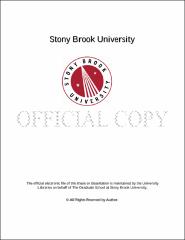| dc.identifier.uri | http://hdl.handle.net/11401/76300 | |
| dc.description.sponsorship | This work is sponsored by the Stony Brook University Graduate School in compliance with the requirements for completion of degree. | en_US |
| dc.format | Monograph | |
| dc.format.medium | Electronic Resource | en_US |
| dc.language.iso | en_US | |
| dc.publisher | The Graduate School, Stony Brook University: Stony Brook, NY. | |
| dc.type | Thesis | |
| dcterms.abstract | Biomineralization is a process in which living organism grow composite materials consisting of inorganic and organic materials. This produces a composite material consisting of both inorganic and organic components, with superior mechanical properties. In the human body bone and dentin are both examples of biominerals. In this research Raman spectroscopy was used to characterize dentin from mice and human teeth, to determine composition. In the mouse tooth samples areas of irregular dentin were found, along the inside of the tooth, to be in the process of mineralization. By analyzing the samples along these areas we were able to determine the composition of dentin and track how it changed in these area. By analysis of the mineral to matrix ratio the areas of irregular dentin were determined to have less mineral present. Observations of other organic components and collagen in increased concentrations in this area suggested these area were in the process of biomineralization. The understanding of the structure of dentin and its biomineralization process is of crucial importance when trying reproduce dentin. Scientists and engineers are able to produce dentin minerals in vitro by culturing various dental stem cells. The ability to create dentin mineral from cells could lead to methods of repairing dentin in patients, or even lead to the creation of a completely engineered tooth. While dentin-like materials can be produced in a laboratory environment, analysis and comparison of the composition of these materials must be performed to ensure the mineral produced is consistent with dentin. Mineralized nodules from six different dental stem cell lines were cultured to produce a mineralized deposit. Utilizing Raman spectroscopy, we were able to determine cell source dependent differences in a variety of dental stem cells, and compare the mineral produced to native dentin. Orthopedic implants are implants used to replace damaged bone, examples include knee, hip and dental implants. These implants are designed to osteointegrate with the native healthy tissues in order to create a functionally stable and structural interface. Biomaterials such as hydroxyapatite and titania are known to increase the rate of bone regeneration in vivo.1 By accelerating the early response of bone forming cells to these implants, better fixation is achieved between the implant and the bone, shortening recovery times and increasing the viability of these implants. In the last part of this research an investigation of osteoblasts cultured at 14 days on five different heat-treated titania substrates was investigated by Raman spectroscopy, in order to observe the initial cellular response to the titania substrates. The heat-treatment of titania changes the amount of oxygen on it's surface which in turn effects the surface energy. A change in the surface energy of a material will affect the cellular response, by culturing cells on various heat-treated titania substrates a relationship between the surface energy and cellular response can be investigated. A faster cellular response would lead to an increased rate of bone regeneration shortening healing times and allowing for better fixation of the implant. | |
| dcterms.available | 2017-09-20T16:49:59Z | |
| dcterms.contributor | Meng, Yizhi | en_US |
| dcterms.contributor | Gentleman, Molly W | en_US |
| dcterms.contributor | Rafailovich, Miriam. | en_US |
| dcterms.creator | Fatscher, Robert William | |
| dcterms.dateAccepted | 2017-09-20T16:49:59Z | |
| dcterms.dateSubmitted | 2017-09-20T16:49:59Z | |
| dcterms.description | Department of Materials Science and Engineering. | en_US |
| dcterms.extent | 95 pg. | en_US |
| dcterms.format | Application/PDF | en_US |
| dcterms.format | Monograph | |
| dcterms.identifier | http://hdl.handle.net/11401/76300 | |
| dcterms.issued | 2014-12-01 | |
| dcterms.language | en_US | |
| dcterms.provenance | Made available in DSpace on 2017-09-20T16:49:59Z (GMT). No. of bitstreams: 1
Fatscher_grad.sunysb_0771M_12048.pdf: 27313567 bytes, checksum: f2e8ce704ffabc6cd74b5d94cd9a9404 (MD5)
Previous issue date: 1 | en |
| dcterms.publisher | The Graduate School, Stony Brook University: Stony Brook, NY. | |
| dcterms.subject | Biominerals, Hydroxyapatite, Osteointegration, Raman | |
| dcterms.subject | Materials Science | |
| dcterms.title | Investigation of Biomineralization by Raman Spectroscopy | |
| dcterms.type | Thesis | |

